As an Italian, I consider the three great masters to be Michelangelo, Raphael and Leonardo da Vinci. Similarly, there are also masters in this hobby and I have been fortunate to see their works of art, the tanks of Wayne Shang, Chingchai Uekrongtham and David Saxby are indeed masterpieces.
Over the years I have been able to actually visit and see two of these three amazing tanks in person, and have recently visited David for two days along with my friend Tony Vargas, and David graciously allowed us to pick his brain for two days to discern the secrets to his success. As with his friend Martin’s tank, David’s tank is unlike any I have seen anywhere else. To me at least, I consider it perfect in both form and function, from it’s construction and design, to it’s stocking of both fish and corals and finally in the equipment used on it and it’s maintenance.
When entering David’s fabulous home, the tank is not the first thing you see, but rather the first thing you see is the incredible décor and that everything from the 18th century ship’s barometer by the door to the 17th century English tapestry hanging on the wall near the tank, are as perfectly laid out as any magazine spread. And even the tapestry is appropriate, as even the cherubs in the tapestry are fishing.

As you move through the dining area you start to notice the unmistakable blue light emanating from the room next door. As you get closer, you wonder how can this tank possibly match the beauty of the rest of the house and more importantly how can it not look like a usual tank and as a result not fit in with the rest of the house.
This is where David’s background in design comes in, as he has built the tank and all of the necessary support equipment so that it all fits in with the rest of the house’s décor perfectly. There are no wires, sounds, or smells to ruin the tranquility that runs through the house. There is just the beauty of the house augmented by the beauty of the tank and its inhabitants.
Just as Martin’s tank is amazing to behold, so too is David’s, but for a lot of different reasons. This tank is also quite large for a home tank with it’s largest piece of glass, which is the view from the living room, running over eleven feet in length and almost four feet tall. The tank is unique as it is L-shaped with the long end being over 11 feet long, with the portion between the doors on the side being over 7 feet and the inside end of the L being over 5 feet. It is designed to provide multiple views from each spot, each of which makes the tank look completely different.
While the tank design itself is unique, this is just the start. Due to its non-rectangular shape and large size, finding a way to brace it properly was one of the first problems to be overcome. Having had problems in the past with structural integrity, which I will discuss later, David came up with a completely innovative way to keep the glass viewing panels in place.
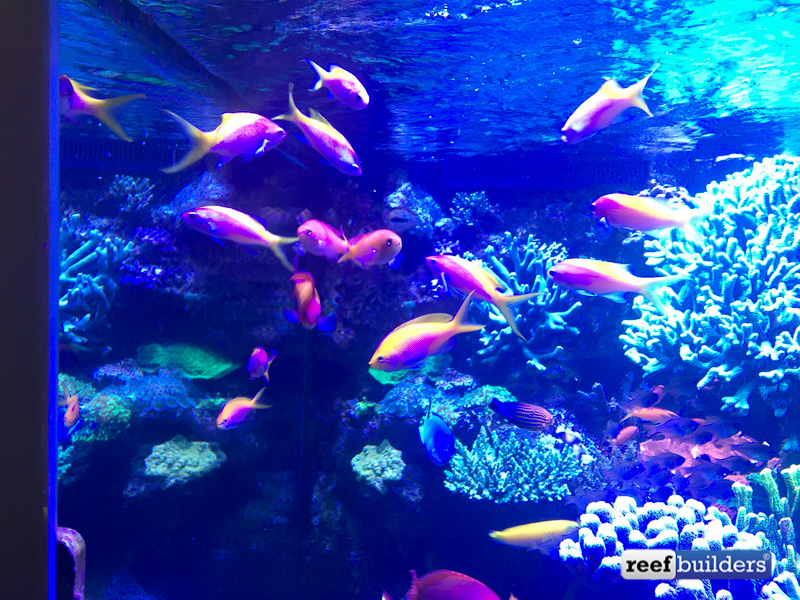
The rear panes on the blind side of the tank are not euro braced as this would not allow the overflows to function, but include holes drilled near the top of the glass to accept threaded bracing cables that are pushed through the hole and then through a piece of stainless steel that is form-fitted to match the contour of the glass that runs along the back of the tank. A rubber isolation gasket is installed between the stainless steel and the glass to prevent direct contact between the steel and the glass.
A rubber grommet is pushed into the hole in the glass to prevent any contact between the glass and the stainless steel rod as that would damage the glass. A locking nut is then threaded to the rod and rests against the stainless steel form on the outside of the pane so the cable tension can be adjusted to lock the rod in place. The tank is “Euro-braced” with 2 X ½” thick and 4” wide-laminated tempered glass all around the inside front and sides of the tank.
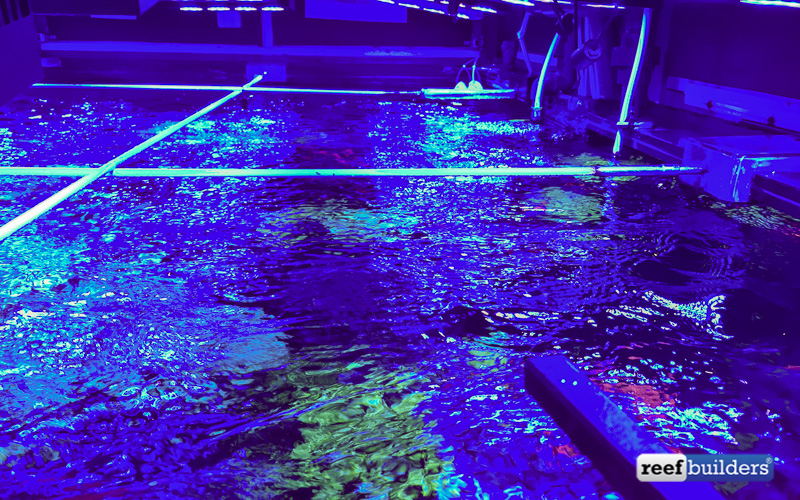
On the front braces of the tank stainless steel blocks are employed to pick up the end of the stainless steel cables. These blocks are located on the glass braces using pins that are sleeved with rubber, the upper ½” layer of the laminated brace was drilled before tempering to accept pins on the blocks so they could be mounted into brace holes and then could be epoxy glued into place. They are then encased in glass as an added precaution to prevent the corrosive activity of saltwater from occurring.
Each of the stainless steel blocks were pre-drilled and threaded to allow the threaded ends of the stainless steel yachting cables to be screwed into the block and run across all sides of the tank and put under tension via the nut that is flush against the side of the opposite wall of the tank, thus holding the glass perfectly in place, not allowing even minimal bowing or any other movement of the large sheets of glass to occur regardless of the direction.
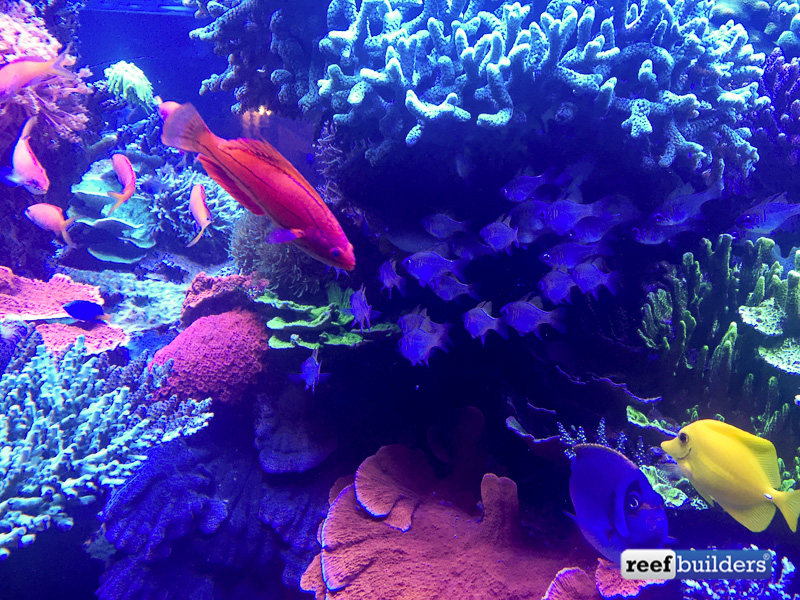
How well this system is functioning can be seen when you look across the front eleven-foot pane and see that it is perfectly straight from edge to edge. Having worked on a number of large tanks, this new and unique design is far better than many of the bulky methods I have seen used on big tanks. Just as importantly this system did not require any other bracing across the tank and as a result there are no spots where light cannot penetrate.
To further add structural integrity, the tank was not sealed with the customary silicone, but was instead built using a special industrial marine safe 2-part epoxy silicone that is used for hurricane windows on tower blocks. As a result, it is structurally stronger than a tank glued with standard silicone would be. The structural epoxy is fast setting and the tank can be filled within 2 hours of application.
But this is just a start to the innovations and technology used in this tank. Unlike most large tanks where the technology is housed in the basement or adjacent garage, for this tank David placed the filtration and all related technology in a 200-year old cellar approximately 40 meters away. Both the tank and the filter room are sited at the same level. Therefore gravity cannot be used to return water to or from the tank.
After the water flows over the overflow on the blind side of the tank it is piped by gravity to a large sump beneath and can be pumped to either a skimmer, a RowaPhos reactor or a Genesis power roll filter or to the sump room outside. The RowaPhos reactor, Genesis filter and skimmer are all located in the pull out cupboard next to the tank. The cupboard is designed so that it is invisible, and is in kind of a secret passage.
From the sump, water is moved to the filtration room via an Abyzz pump with the pipe within the ceiling of his home using one unbroken length of 2” flexible ABS pipe. All of the plumbing, both to and from is hidden on the outside of his building. The filtration room is 10 X 11 feet square and it contains virtually every piece of equipment you can imagine to keep the tank’s water pristine and stable.
There are two Deltec protein skimmers in this room, the largest being the biggest non-commercial unit Deltec makes, through which most of the water from the tank flows after first passing through the Genesis mechanical roller filter. The other one sits in the chamber next to the double nitrate reactor. This is done to keep any anoxic water from going into the tank, as well as removing any bacteria or organics that typically comes out of a nitrate reactor.
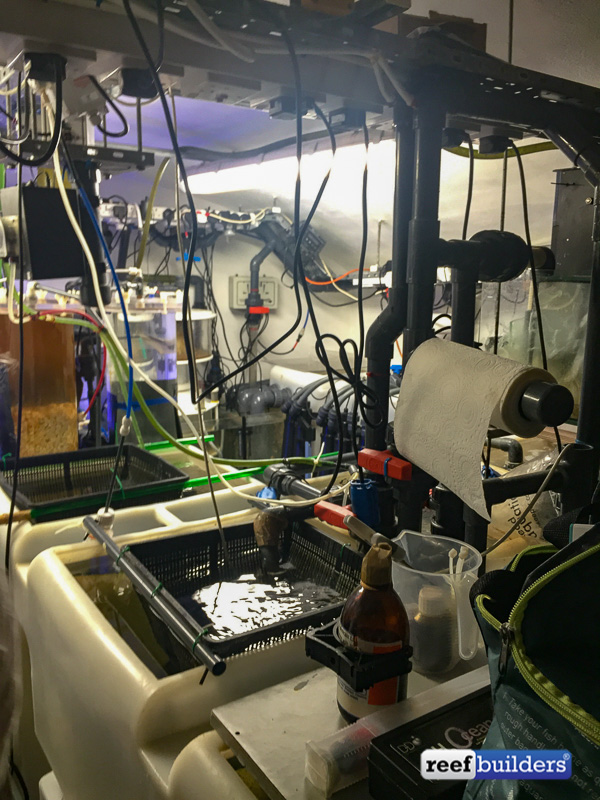
In the filtration room, there over 1300 gallons of water in various sumps, reservoirs, as well as multiple dosers, probes, UV sterilizers, as well as a glass quarantine tank. Nothing goes into David’s tank unless it has gone through quarantine first. In a tank this big if a pest of any type were unleashed it would be devastating.
Like Martin’s system, David also employs an extra large custom designed Destaco Calcium reactor. Due to the size of this tank and the amount of corals it houses and how much calcium and carbonate they consume the dual units are almost 8-inches in diameter and five feet high. And as was the case with Martin, this unit maintains the proper levels of between 7-8 dkh and can be adjusted at the simple turn of a dial to increase/decrease the calcium and alkalinity from the reactor effluent.
This also helps him to maintain his calcium level at what he his found his optimum to be of between 440-475ppm. All told the tank, sumps and reservoirs contain approximately 3250 gallon of water, with the tank itself holding just over 1300 gallons. After going through all of this filtration and monitoring, the water is pumped back via a second Abyzz pump to the skimmer chamber where it is pumped back into the tank.
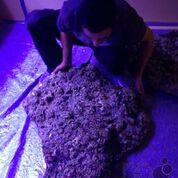
This is done as a precaution to make sure that no “dirty” water makes its way back into the main tank. To keep things balanced multiple float switches are employed to keep the tank, sumps and reservoir levels stable. In addition, gate and check valves are employed throughout the plumbing allowing any piece of equipment or reservoir to be taken offline for maintenance, cleaning or repair.
While all of this may seem kind of standard, just bigger, there is nothing standard to the lighting and water flow that is employed in this tank. Lighting is provided by 28 AI Hydra HD LED fixtures, 19 are 52 HD’s and 9 are 26 HD’s. These lights are run on 8 different programs with the lights tailored to suit their position and the corals beneath each light. As a result, David has found it possible to bring out the colors of specific corals to an even greater extent than most of us do.
Because there are 94 LED pucks over this tank, he has found it possible to place them so that there are virtually no dark areas within the tank. Some of these fixtures are even angled so that their light is directed under overhangs and into caves, so that corals can grow virtually everywhere in the tank. By angling the lights and adjusting them over time, it has even been possible to keep corals growing even after the corals above them have overgrown them and started to shadow them. I had not seen this accomplished in a tank before.

Like me, David likes his light on the blue side overall, but it varies quite a bit over the day and ramps down to a bluer spectrum in the evening, with evening even coming close to looking like sunset. But unlike most of us who just have the lighting program ramp slowly to the max and and stay there David has programmed his lights to ramp up to near maximum intensity, then they spike for 15-30 minutes, drop back down to 80% intensity for 30 minutes then spike again.
This program then repeats itself for approximately 6 hours. David feels that by only having the intensity spikes for short periods followed by less intense spikes the light more closely mimics what occurs on the reef as the sun moves across it. In addition, he has found that this prevents any bleaching of the corals as he has found that these short bursts of high intensity light allow the coral to tolerate the light better.
After looking at the growth and health of the corals in David’s tank, it is easy to think that David may be on to something. It should also be noted that before David switched to all LEDs, metal halide lamps were employed with great success. Obviously due to the amount of heat these lamps generated some means for cooling the water needed to employed. In order to accomplish this, 4 large chillers were employed to maintain the temperature. Now that only LEDs are employed a single chiller is all that is needed and rarely needs to be employed.

Having a unique lighting system was not enough, as David also decided that he wanted strong random flow throughout the tank to mimic nature, but that it also had to be invisible. So in order to produce this flow 3 Abyzz 5000 gallon return pumps are used for return pumps to return water to the aquarium from the sump, as well as 5 other Abyzz pumps on closed loops and with various wave maker programming.
All told 13 Abyzz pumps are required for water movement on the display system and if they were all on at full capacity approximately 150,000 liters of water per hour would be moving throughout the system. While this sounds impressive, if it were just moving water in a straight line it would not be anything new or innovative, however this tank even has an innovative design to its water flow.
First, suction pipes are hidden behind a protective glass sheet so the pipes can be removed for cleaning. Even more important from a standpoint is that all of this was done without drilling the base of the aquarium. So in order to hide the pipes on the bottom of the tank and not have another 1.5” of potentially dead substrate, David built up the base of the aquarium glass around the closed loop pressure pipes with glass strips to form channels that the pipework sits in.
This culminated in the base of the aquarium being brought up level with the top of the pressure pipework, he then added substrate to the aquarium to fill the channels and hide the piping. As a result, there is only 1-1 1/2” inches of substrate throughout the tank. Because of this innovative design, it is almost impossible to see where flow is being generated from in this tank.
This flow is also not just the standard on and of, but instead there is constant random ramping up and down of the pumps so that the flow throughout the tank seems to change constantly. One of the more interesting things this produced is that if you looked carefully you could watch the school of blue-streaked cardinals bob and move en masse under a coral head as the flow made them drift from point to point.
Then suddenly a surge in the area would occur and the bigger fish would seemingly surf against it and through it and as a result move through and around the school of cardinals in a kind of reef ballet. It was one of the more interesting displays of behavior I have ever seen in a closed system.
Before I get into the corals and fish, which David houses in this tank, I should mention that all of this was not achieved without David overcoming some self-created mistakes and the steep learning curve of the hobby along the way. Over the past 17 years that I have known David, the entire tank was taken down and rebuilt to some degree several times.
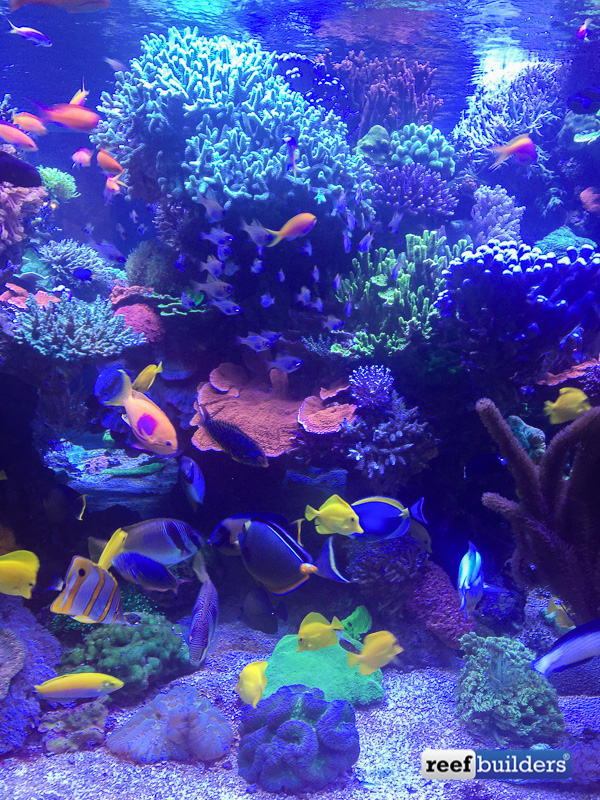
Once it was due to adding fish that became predatory, and twice it was due to structural failures in the tank or plumbing and once due to a custom made heat exchanger, which was specified to be manufactured from Titanium, but unfortunately the manufacturer used copper pipes covered in plastic without informing David instead. Over time the plastic coating breached and released copper into the tank. David picked this up due to observing ongoing health issues and after revamping his system and installing a new heat exchanger David cut open the old heat exchanger and his suspicions were confirmed.
Although there was a residual reading of copper at very low levels shortly after restarting the system due to some older pipework still being in place, this quickly dropped back to undetectable levels. In its latest incarnation David added an extra 18-inches in length along the front and upgraded much of the equipment to bring it to as near of perfection and while making it as energy efficient as possible.
I mention this not to diminish what David has accomplished, but to show that almost everyone in this hobby is not immune to mistakes. In this regard David even told us that 11 months or so ago he inadvertently had an 8-liter container of vodka, his food source for his nitrate reactor, dosed into his tank in one dose. As a result, he lost about half of his fish and it damaged or killed many of his corals.
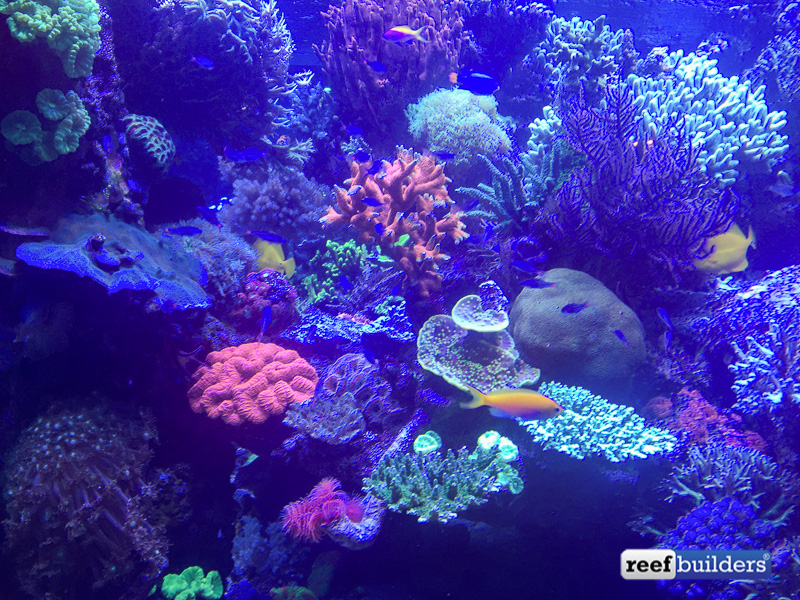
I mention this as the pictures I have included show how much growth he has gotten from the frags he re-started with in little more than 11 month’s time. More importantly like many of us the maestro has tried to learn from his past mistakes. The vodka dosing system for instance, now has failsafes designed into it so it can now only dose a maximum 200ml (A small amount of vodka in relation to total water volume) at one time and so that this mistake cannot be made twice. All that is left from this mistake are a couple of small patches of residual Bryopsis.
Having said that, when looking at the tank itself it is hard to believe that any mistakes have ever occurred. Due to how well conceived and then implemented this tank was, virtually every spot in the tank is filled with living corals. Obviously sps corals dominate, but there are also several large soft corals including a massive green-polyped leather coral as well as acans, Scolymias, plate corals, gorgonians and even a sun coral that has begun producing offspring at a rapid rate, so that there are now numerous offspring under many of the overhangs and caves within the tank.
The size, health and coloration of the corals are spectacular, especially when one considers the relative short time they have been in the tank and that most were started from frags. Much of this no doubt is the result of of the conditions, and the ability to adjust the light spectrum and intensity with ease. David maintains some nutrients in the tank, with it having, (PO4-.015-.04, with his sweet spot being .02, and nitrate ideally around 2ppm), but not 0 nutrients, but more importantly is how stable David maintains the tank’s parameters. In this regard, David not does only do testing and monitoring on his own, but he also sends in a weekly sample to Triton for testing.
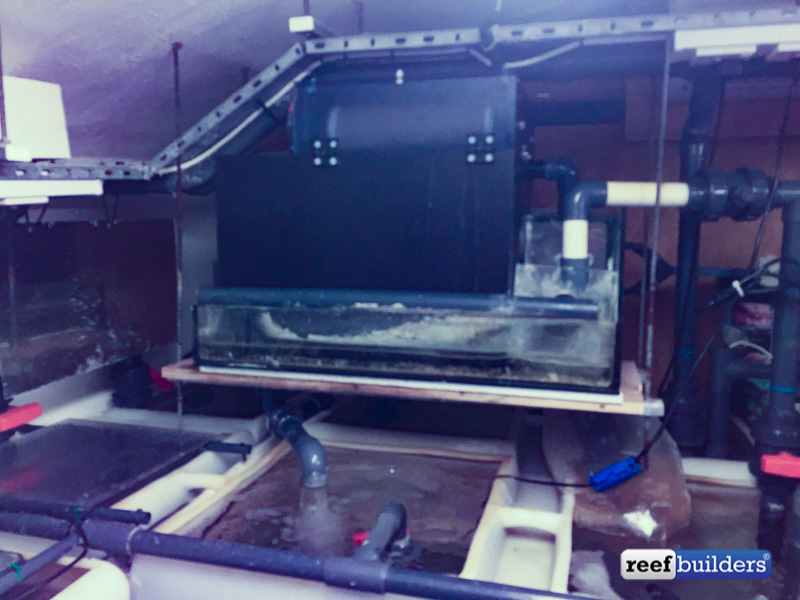
As a result, if any trace element is low he can rapidly replenish it, using Triton’s supplements, especially Strontium, Iodine, Manganese and Molybdenum. Conversely if anything is in an excessive amount he removes it by doing a large water change using D&D H2Ocean salt, over 20% to a maximum of 50% brought online over 3 or 4 days to prevent shocking the tank’s chemistry. His standard is to do approximately 10% per month, but if there is a problem his system is designed such that he could do a 1500-gallon water change with just the turn of a few taps.
While the corals in this tank are spectacular, it is the fish that truly bring it to life. While many of us aspire to house a school or shoal of fish in our tanks, David’s tank houses no fewer than 4 of them. In addition to the school of 45+ blue-streaked cardinalfish, there is also a school of 30 red-spotted cardinalfish that live on the opposite side of the tank. Then there are the schools of anthias, including Ignitus, Dispar, Bartlett’s and the relatively rare and stunning Smithvanizi moving constantly en masse throughout the tank.
These are just the start however as there is also a shoal of 22 yellow Tangs, 3 Scopas tangs, a trio of Genicanthus, a pair of two-year old Choat’s wrasses, Femininus wrasses, multiple leopard wrasses, a Yellow headed jawfish and numerous other tangs and anthias, dwarf angels and fairy wrasses and an interesting trio of bicolor goatfish. These are fish that I have never seen in a reef tank before, but at present are only 5 inches in length and to date have not harmed any of the other inhabitants.

All told there are probably over 300 fish in the tank, and they are as fat and healthy as I have ever seen in any tank. I say this as one of the fish in this tank that really stands out is a Powder Blue tang that is far and away the fattest tang I have ever seen. While it’s girth is a testament to it being well-fed more telling is what happens at dusk every night.
Sitting back and watching the tank as the lights begin to fade it quickly becomes apparent that unlike most tanks, where activity diminishes as the tank darkens, in this tank activity increases. This is because numerous fish begin to spawn or flash. This tank houses many fairy wrasses, as well as the biggest flasher wrasse I have seen and at dusk many of them start swimming around flashing the other wrasses in the tank. At the same time the anthias start swimming to the surface intertwined with one another in their spawning ritual. And just as interesting, a pair of blue devil damselfish, the female so plump with eggs she looks ready to burst, have excavated a burrow under a large plate coral and they take turns entering the cave to spawn.
All told while we were there we saw no fewer than 5 different species of fish attempt to spawn. I do not know of a more telling testimony to the health of a tank than that. It was also interesting that at dawn and dusk many of the fish lined up near the cleaner shrimp station, where 10 eel cleaner shrimp reside. The fish would move near the shrimp so they could be cleaned thoroughly by this troop of shrimp and take turns being cleaned. It was fascinating to watch.
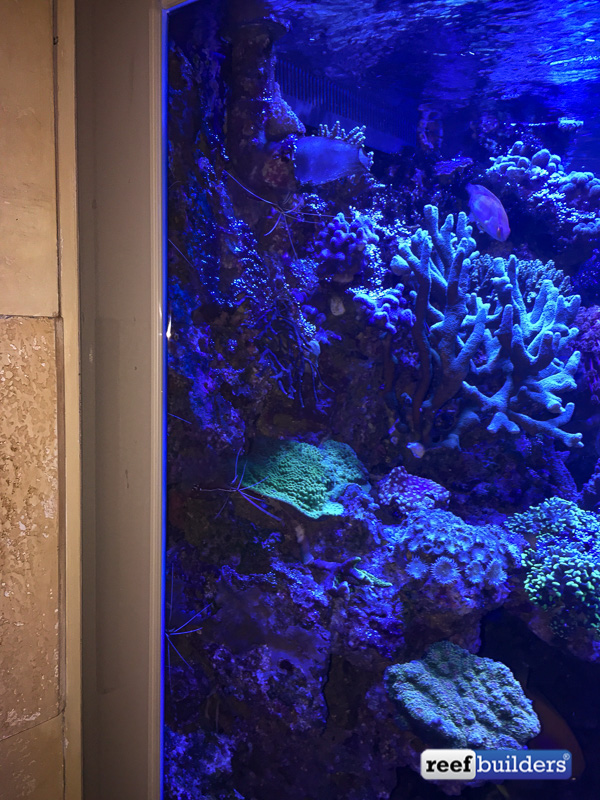
For the most part, David does not feed his corals directly, not even the sun corals, but he does feed what many of us would consider a large amount of food several times a day including 3 feeds of frozen food and one of live shrimp. David also mixes Polyplab ReefRoids in with his frozen foods and feeds this once as he feels this feeds his coral indirectly due to the fine food in the water column reaching everywhere due to the incredible water movement.
He also does feed Nori and lettuce to nourish the many Tangs and Angels in his tank. This large amount of food and the waste that the large number of fish produce no doubt helps to explain why the fish and corals both look well-nourished. He can do this as a result of this tank employing some of the best filtration and monitoring equipment available and this along with the regular water testing and water changes and David’s insight as to how things “look” help to maintain the water conditions at optimal levels.

One of the benefits of traveling is getting to see tanks and shops in person, as despite our best efforts photographs and videos do not do them justice. And when I see these tanks and learn from the masters I try to share what I have learned with you. I realize this was an extra long piece and I appreciate your reading it all, but I did not want to leave anything out as the uniqueness and innovations are worth understanding.
After seeing David and Martin’s tanks in person, I realize I know very little and now have the notion of tearing down my own tank and starting over. However, as they both have said they did not achieve this level of success without there being some failures and problems along the way. For them and for me, the key is to learn from them and not repeat the same mistakes.
Every time I see tanks such as these I realize how lucky I am to have these opportunities and also how far our hobby has come. When looking at tanks such as these, it really is like looking at a small portion of an actual reef in a home. It is also great that for the most part these tanks house what some might consider common or mundane corals, but their size and health more than compensate for their not being “named”.
Hopefully these last two articles provide inspiration of what can be accomplished and if you have a tank like these I would love to see it. In the mean time, I will let you know if I tear down my tank and start over and try to emulate these masters.



